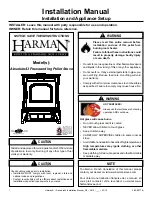
• Check for flue or chimney blockage, and clean if
required.
Seek expert advice from your HETAS registered
installer. Do not attempt to re-light the fire until the
cause of the fume emission has been identified and
corrected.
ASH REMOVAL
- Wood burner only
Ash will drop through the holes and to the slides of
the specially designed wood tray. This should be
removed from the stove periodically. It is advisable
to leave a layer of ash on the wood tray to prolong
its life and maintain optimum conditions for
burning wood.
ASH REMOVAL
- Multifuel Stoves only
The ash pan should be emptied at least twice a day
or when the level of ash reaches the top of the ash
pan. On no account should the ash be allowed to
build up to touch the grate as this will greatly
shorten its life.
DE - ASHING - Multifuel Stoves only
It is necessary to maintain an ash layer on the upper
surface of the grate bars, in order to protect them so
de-ashing should cease as soon as the first red
embers drop into the ash pan. Further de-ashing
will cause heat build-up under the grate, which will
considerably shorten its life. This operation should
be carried out with the doors closed to prevent dust
escaping into the room.
•Move up and down vigorously the riddling
lever (ash will fall into the ash pan beneath
the grate).
•When de-ashing is complete re-set grate to
previous position.
• Empty the ash pan.
Note: Do not force the riddling lever.
TO EMPTY THE ASH PAN
Open the fire door. Fit the fork end of the operating
tool into the ash pan and remove from the ash
chamber.
Note:- The ashpan can only be removed when the
grate is set to coal position.
WARNING:
The ash can be very hot. Empty only
into a metal container. Even if the ash appears cold,
red-hot pieces of ash may be concealed and could
easily start a fire or cause an injury. Replace the ash
pan and close the fire door.
CLINKER
The formation of clinker suggests that the unit is
being over-fired. Any clinker forming on the grate
should be removed when cold.
OVER-FIRING
Do not
over fire your appliance. Using flammable
liquids or too much wood or firing the fire at
maximum for prolonged periods may result in
over-firing. If the chimney connector or casing
glows red it is being over-fired. If this occurs
immediately close all air inlets to the appliance to
reduce the air supply to the fire. Should a chimney
fire occur immediately close the appliance down.
Get everyone out of the house and call the fire
brigade. A chimney fire may cause structural
damage of the chimney. Do not use the appliance
until the chimney and connector have been
inspected and any damaged parts repaired or
replaced. This should be done by a competent person
such as a HETAS registered engineer.
CLEANING
IMPORTANT
Under some circumstances soot can quickly build
up on the throat plate and adjacent areas. The throat
plate should be removed and checked monthly, and
any debris stripped off. Similarly, clean the upper
surface of the firebox.
Refer to page 17 for instructions on throat plate
removal/inspection.
ANNUAL MAINTENANCE
It is important that your fire is regularly serviced in
accordance with these instructions. This should be
carried out at least annually by a qualified person
and should consist of the following.
Please ensure that your fire is left clean and moving
components are well lubricated for the summer
(during periods of prolonged non-use). If possible
store the throat plate outside the fire, check all
moveable components, at regular intervals, to
ensure they are moving freely. Allowing the
maximum air movement through the fire.
Camborne Wood & Multifuel Stoves
13
OPERATING INSTRUCTIONS














































